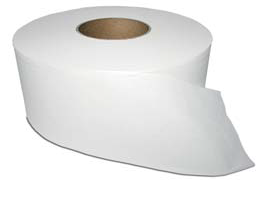
Standard roll
- Also known as small roll
- Used in all types of facilities
- Available in one- or two-ply
- Generally individually wrapped
- 96 rolls per case, 500 sheets per roll OR 80 rolls/case and varying sheet count (new industry standard)

Jumbo roll
- Used in high capacity washrooms
- Available in one- or two-ply
- Not individually wrapped
- Sizes
- 9" or JRT Jr. (more common)
- 12" or JRT Sr.
- Standard Lengths:
- JRT Jr - 1-ply has 2000' on a roll, 2-ply has 1000' on a roll
- JRT Sr - 1-ply has 4000' on a roll, 2-ply has 2000' on a roll
Branded Proprietary Tissue
- Look like and are similar to standard and jumbo towels
- Notched, sized, or made coreless, such that they only fit a proprietary dispenser
- Various versions are produced by most branded manufacturers
- Available to only select distributors or end-users
Examples:
- Kimberly-Clark's Coreless, Georgia Pacific's Cormatic, Compact Coreless, RollMastr
| Rule of Thumb | Lead with private label restroom paper versus more expensive national brands. |
| When choosing toilet/bath tissue, remember... | 1) Check how many individual units/rolls are in the case and calculate the cost per unit/roll » Fewer units/rolls in a case can give the appearance of a better value if only the price is considered » Calculating and comparing the cost per unit/roll will give you a more accurate read on the value being offered 2) Compare the number of sheets and size of the sheets to compare the cost » Break the cost down by the number of sheets, if necessary, to compare price » Verify the size of the sheets. A smaller sheet equals a lower cost. » Short or narrow sheets drive down the cost because there is less paper (and raw material) 3) Compare the type of paper » Embossed or quilted? Quilting/embossing adds higher absorbency, softer feel and additional cost versus "flat" sheets. They are more expensive because of the additional expense associated with enhanced raw materials and processes to finish the paper. » Whiter, brighter sheets? Making whiter, brighter sheets is a process that needs more virgin pulp to produce a whiter product. » One-ply or two-ply? Using less material reduces cost. 4) When in doubt, weigh the individual roll or case. That will help determine the quality of the product » Some manufacturers will "cheat" on paper basis weight to drive down the price with a lower quality product. They "cheat" by offering a product with thinner weight or thickness paper in its raw material state. » Loosely wrapped paper rolls can give the appearance of a larger roll but actually have much less paper on it. |
| Why is that product cheaper? |
|


